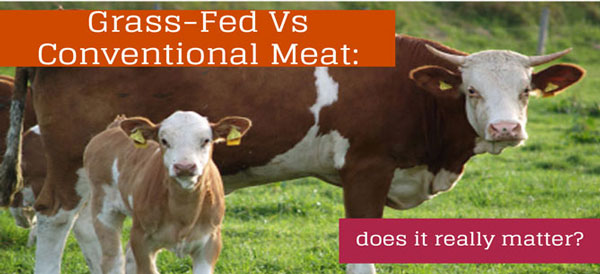Today I’d like to focus on something that is incredibly close to my heart: the importance of the source of your meats. I was a vegetarian for about 10 years–starting at the age of 12–and my reason for not eating meat was my bleeding heart for animals’ welfare. I’m about to go a little PETA on you for a minute, so beware.
When I decided not to eat meat, it was because I’d read The Jungle by Upton Sinclair, and I didn’t want to have anything to do with a cut of steak that came from a cow that wasn’t quite dead while it was being butchered. Or a chicken whose beak was melted down to a nub so it couldn’t anxiously peck the eyes out of its featherless cage-mate. Or a pig that was fed its own feces while standing forever in a pen that just barely housed its obese body.
But after about 10 years of not eating meat, I needed the dense protein that only animal flesh can provide. I was sick, and I needed to eat what I am “programmed” to eat. Once I started doing that, I started healing.
Eating Meat As An Animal Lover
However, it wasn’t like I just started eating any old meat I could find. I began researching all the different brands of meats to find out how their animals were treated before and while they were slaughtered. I wanted to eat animals that were given a proper environment to thrive in with clean food and pure water to nourish them. And it turns out that the better they’re treated, the better they are for us to eat.
When a cow or (enter animal here) lives its whole life eating GMO corn and not moving around, its body takes note. If you were to eat corn and not move around, your body would take note, too (as about two-thirds of the American population can attest to). You get fat and so do the animals.
Grass-Fed Vs Conventional Meat
And as they say, you are what you eat. And so are cows. There’s a big difference between the nutritional and humane value of grass-fed vs conventional meat. The fat content is a lot higher in an animal who’s been corn fed and under-exercised than one who’s been grazing on grass and moving around its whole life. It’s like the difference between the body composition of a sedentary obese guy and a, well, hunter gatherer who walks, reaches, runs, jumps, and manipulates his environment to get what he needs. Your whole body changes when you do these things, and so does the fatty acid and protein content of your body. You get more muscle and less fat.
The kinds of fatty acids you’ll find in a grass-fed cow are much different than a factory farmed animal, too, which is even more important than the amount of fat. There is more conjugated linoleic acid (CLA) and omega 3 fatty acids in grass fed animals because the grass itself contains more of those beneficial fatty acids (1). CLA has some anticancer effects and may help you firm up that belly fat(6).
And as you probably know, omega 3 fatty acids are the kind of fats you find in abundance in fish, and they are anti-inflammatory. I’m not just talking about the kind of inflammation you have when you’re in pain, either, like with a sprained ankle or arthritis. Inflammation is behind everything from diabetes to MS to cancer to migraine headaches, not to mention heart disease. You want to fight inflammation anyway possible, and eating pasture-raised beef & eggs is one way to do it.
How Much Omega 3 Is Really In Beef?
For instance, there are 38.5 mg of omega 3’s in 3.5 oz of grain fed beef, while there are 93.2 mg in grass fed. That’s almost 3x the amount of inflammation-fighting fatty acids in grass fed beef. On the other hand, that same 3.5 oz of conventional, grain fed beef contains 285 mg of omega 6 fatty acids, which are the pro-inflammatory counterpart to omega 3’s (read: not good for you in abundance). That’s compared to 171 mg in grass fed beef (1).
Now compared with 3.5 oz of wild caught Alaskan salmon at 2.2 GRAMS of omega 3’s , there’s not that much in beef (3). To put this all into perspective further, if you were to take a good fish oil supplement to try to get your omega 3s that way, a dose is usually about 1-2 gm. (I think the real lesson here is that we all need to be eating more fish…)
But most people in this country aren’t eating salmon: you’re eating burger meat and chicken (4), so we need to get our omega 3’s where we can get them. If grass fed beef is going to have almost 3 times the amount of omega 3’s and almost half the amount of omega 6’s, that’s what I’m going to eat.
And In Eggs?
A conventional large egg houses about 33 mg of omega 3’s. One study showed that a pasture raised egg contains about twice that amount (5).
Other Nutrients
It’s not just the fatty acids that matter, though. Those grasses and weeds (and bugs) that pasture-raised animals consume all make for much more vitamin and mineral-packed meats, eggs, and dairy. There are more carotenoids (vitamin A), more vitamin E, and glutathione (necessary for proper liver detox – I take a supplement of this every day). Pastured beef is also higher in the antioxidants superoxide dismutase and catalase. And these are just the nutrients I could find in a quick overview of the literature.
Organic Isn’t Necessarily Grass Fed
Even if you think you’re doing yourself a favor by buying organic beef, it doesn’tnecessarily mean that the fatty acid or nutrient content of this animal is much different than a factory farmed one. Organic only means that the animal had a little more room to move around, that it was not fed anything that had been sprayed with pesticides, and that it wasn’t given antibiotics at any point in its life.
So, yes, it’s fantastic that organic animals aren’t given antibiotics in their water supply like conventional animals, and that their food isn’t laced with toxic pesticides that will end up in its muscles, which we will eat. BUT it also means that that cow could have been standing in a fairly dirty pen for most of its life, being fed organic corn and other grain silage, which is inherently hard for it to digest.
You Are What You Eat
It’s trite, but it’s true. Do you want to eat a Zenned out cow who lived in a field of grass, happily munching on what IT was designed to eat, or a freaked out cow who is sick from being knee deep in other cows’ manure and eating food that makes its stomachs hurt? Do you want to eat an egg from a chicken who was so obese that she couldn’t even walk or one that was running around in a pasture with her girlfriends eating bugs out of manure piles and grass patches all day?
Do you want to be eating animal products that promote illness or ones that help prevent it? I choose the latter.
Resources:
1. Nutritional Differences between Grass and Grain Fed Beef: Health Implication, Cordain, L.
2. http://www.ncbi.nlm.nih.gov/pubmed/20219103
3. http://www.nal.usda.gov/fnic/foodcomp/cgi-bin/list_nut_edit.pl
4. http://growinggeorgia.com/animalag/1397-per-capita-meat-poultry-and-fish-consumption
5. http://www.motherearthnews.com/eggs.aspx
6. http://en.wikipedia.org/wiki/Conjugated_linoleic_acid
7. http://www.ncbi.nlm.nih.gov/pmc/articles/PMC2846864/












While I agree that grassfed is the best healthwise, I wish people would realise that sometimes the cost is prohibitive . Especially when you have teenagers in the family. Yes , I would be setting promoting long term health , but when it comes down to a choice between paying rent and utlities or buying expensive grass fed beef, I know which always come out as my top choice.